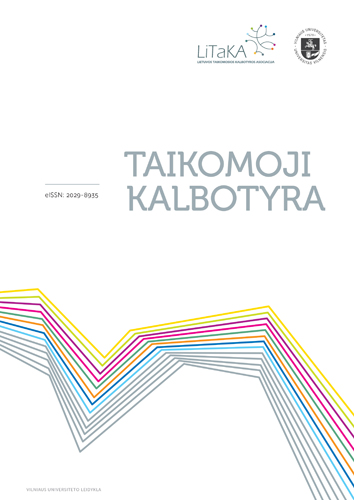Humoras ir kūrybinės kalbos galios, arba Kai sentimentai virsta centimentais
Humour and the creative powers of language, or when sentiments turn into centiments
Author(s): Inesa Šeškauskienė, Virginija Masiulionytė, Birutė RyvitytėSubject(s): Communication studies, Cognitive linguistics, ICT Information and Communications Technologies
Published by: Vilniaus Universiteto Leidykla
Keywords: humour; euro; Lithuanian discourse; Facebook; internet comments;
Summary/Abstract: Humour is part of human communication and can serve as an effective means for making contact, finding a way out of an embarrassing situation, or mitigating different political and social tensions. However, not all humans are born capable of generating and processing humour and it remains an open question whether it is possible to learn and develop this ability. Therefore, a sense of humour, but not an *ability of humour, would be a frequent collocation in many languages. Cognitive linguists claim that collocations are not accidental as combinability patterns point to certain conceptualisation processes in the expression of meaning. The cognitive linguistic viewpoint that humour is based on a mismatch, or incongruity, between ideas, otherwise referred to as frame shifting, is adopted as a prerequisite for producing humour in this paper.The focus of this paper is the expression of verbal humour dealing with the introduction of the euro in Lithuania in 2015. Verbal humour is created by employing different linguistic resources: sounds, spelling, word building models, homonymy and polysemy, word combinations and other syntactic structures and larger chunks of texts or discourse. The investigation is based on the main theories of humour: the Semantic Script Theory and the Superiority Theory developed by Attardo (1994) and Raskin (1985). The empirical material consists of 89 cases of verbal humour found in posts and comments in personal profiles and pages on Facebook and in reader comments following different articles in popular news portals written from September 2014 to February 2015. The paper attempts to describe linguistic means contributing to the construction of humour as well as to identify the shifts between frames involved in generating the humorous effect. The results of the investigation suggest that most humorous comments bear content-related political implications, shifting between the frames of the loss of national currency perceived either as the loss of stability or as the loss of national identity and the frame of positive expectations due to the greater integration into the EU. The techniques used to construct humour include wordplay based on sound combinations, similar spelling, non-standard spelling, and code-switching involving English and Russian. An especially productive technique was the construction of existing or non-existing words by code-mixing and the use of metaphor and metonymy. Larger chunks of text also employ intertextuality, parody, switching between registers and different types of echoing.
Journal: Taikomoji kalbotyra
- Issue Year: 2016
- Issue No: 8
- Page Range: 213-243
- Page Count: 31
- Language: Lithuanian

